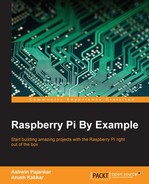Raspberry Pi is probably one of the most versatile computers ever built. It has been adapted for tasks ranging from home automation, cluster computing, computer vision, and even space missions! What's more is that it enjoys a level of support from the community that is hard to find for any other platform.
Due to this, it is a hacker-friendly device and is a must for anyone who wants to build projects with even a little amount of programming involved. The fact that the basic version of the board costs only $25 means there's a lot of room for experimentation, and users aren't afraid to experiment with and damage it.
In this book, you will find a wide variety of projects, using which anyone can get started with and also build interesting hacks by modifying some of the projects.
Chapter 1, Introduction to Raspberry Pi and Python, provides an introduction to the Raspberry Pi and booting it up.
Chapter 2, Minecraft Pi, introduces you to Minecraft Pi, which is a preinstalled version of the popular game Minecraft. The first few pages of the chapter deal with the game concept and interface, and further pages deal with programming in-game actions with Python. In the last part of this chapter, you are introduced to the PyGame library and small usage examples of it.
Chapter 3, Building Games with PyGame, is an introduction to the PyGame programming library and game programming. In this chapter, you code your way to your first full-fledged program on the Raspberry Pi, a game.
Chapter 4, Working with a Webcam and Pi Camera, introduces you to the Pi Camera and regular webcams and how to use them to create real-life applications with the Raspberry Pi. You also create a time-lapse box project in this chapter.
Chapter 5, Introduction to GPIO Programming, introduces you to the Raspberry Pi B+ and Pi 2 GPIO structure and its real-life usage with LED programming and a third-party add-on, PiGlow.
Chapter 6, Creating Animated Movie with Raspberry Pi, demonstrates the GPIO and camera together by creating a project that requires application of both the concepts in order.
Chapter 7, Introduction to Computer Vision, introduces you to computer vision and image processing with Raspberry Pi. You will create a simple project.
Chapter 8, Creating Your Own Motion Detection and Tracking System, introduces you to advanced concepts in OpenCV, which will be used to implement the next project, which has a higher difficulty level.
Chapter 9, Grove Sensors and the Raspberry Pi, introduces you to the Grove shield and Grove sensors and their interfacing with Raspberry Pi. Grove Sensors are third-party sensors for Raspberry Pi and Arduino that can be used for environment sensing.
Chapter 10, Internet of Things with the Raspberry Pi, looks at creating home automation and Internet of Things applications with the Raspberry Pi.
Chapter 11, Build Your Own Supercomputer with the Raspberry Pi, deals with making clusters of Raspberry Pi 2s, using MPICH2 and MPI for Python to write parallel programs for the clusters, and running N-body simulation.
Chapter 12, Advanced Networking with the Raspberry Pi, shows you how to improve your cluster of Pis by adding advanced networking capabilities such as DNS and DHCP. We use of existing cluster for this and make it better.
Chapter 13, Setting Up a Web Server on the Raspberry Pi, delves into installing PHP, MySQL, and WordPress on our Raspberry Pi to use it as a web server.
Chapter 14, Network Programming in Python with the Pi, teaches you how to use Python to learn the basics of network programming and also create network utilities such as Telnet and chat applications on the Raspberry Pi.
Appendix, Newer Raspberry Pi Models, briefly introduces you to some of the newest members of the Raspberry Pi family, namely the Raspberry Pi Zero and the Raspberry Pi 3.
